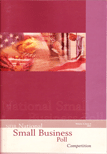Competition
• Small-business owners believe that they operate in highly competitive climates and that these climates are becoming increasingly competitive. Fifty-three (53) percent describe their current competitive climate as highly competitive. Twenty-eight (28) percent believe that it is competitive. Sixty-one (61) percent assess the current climate as much more or more competitive than it was just three years ago.
• Small businesses typically compete against a mix of large and small firms (57%). Twenty-eight (28) percent of small employers say that they compete principally against other small organizations and 13 percent say they compete principally against large ones.
• The location of most competition for small businesses is local. Forty-nine (49) percent of owners say that their principal competition is located within 10 miles of their business. Another 26 percent report it is located within 100 miles. Only 4 percent indicate that their greatest source of competition originates outside the United States.
• Large chains or box stores and foreign businesses can constitute competitive threats to smaller firms. Twelve (12) percent of small-business owners indicate that a box store or a large chain store is a significant competitor, though another 13 percent say that they are a marginal competitor. Meanwhile, 8 percent report that businesses outside the United States are significant competitors and 9 percent more say that they are marginal competitors. When given the opportunity, few small-business owners complain that either competes illegally or unethically.
• Governments and non-profit organizations such as universities, hospitals, and trade associations, also engage in commercial activities and potentially deprive small-business owners of customers and sales. Two percent report that government is a substantial competitor while 4 percent claim it is a marginal competitor. Two percent also report a significant competitive impact from non-profit organizations and another 6 percent claim a marginal impact.
• One in five (21%) small-business owners believes that a major competitor is competing illegally or unethically against him. The most frequent offending behavior is competitors not following the rules. For example, 8 percent of the 21 percent or about 2 percent of the population allege that a major competitor is violating copyright laws. A less frequent problem appears to involve unseemly, but amorphous behavior such as bad-mouthing another’s firm. Virtually no one alleges such traditional anti-competitive practices as monopoly, price fixing, etc.
• Two ways of competing dominate small-business owner strategies. The first is highest possible quality and the second is better service. Over 80 percent insist that each is a major portion of the way that they attempt to compete.
• Less common ways of competing than quality and service are in order: minimal overhead, maximum use of technology, targeting missed or poorly served customers, more choices and selection, unique marketing, lower prices, expansion or growth, a superior location, new or previously unavailable goods and services, alliances or cooperation with another firm or firms, and franchising.


